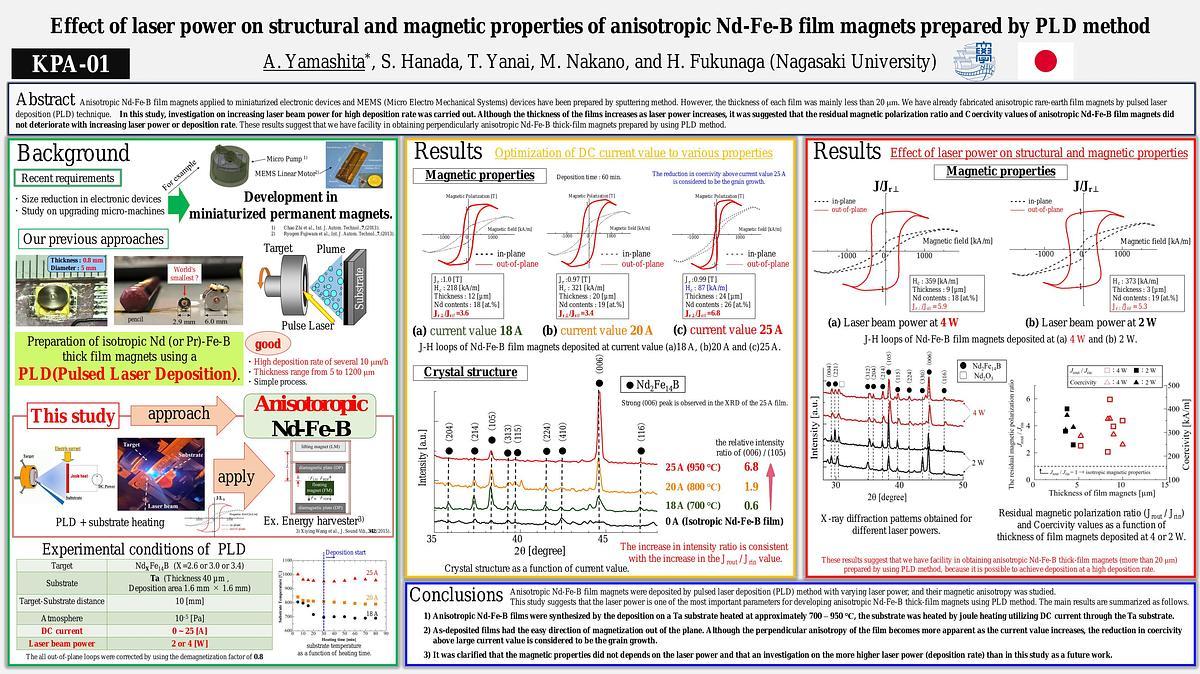
Premium content
Access to this content requires a subscription. You must be a premium user to view this content.

poster
Effect of laser power on structural and magnetic properties of anisotropic Nd Fe
Anisotropic rare-earth thick-film magnets have various applications such as MEMS (Micro Electro Mechanical Systems) devices and miniaturized electronic devices1. We have already fabricated anisotropic rare-earth film magnets by the substrate heating3. In the substrate heating process, increasing the deposition time might cause the grain size of Nd-Fe-B to increase. Our approach to anisotropic Nd-Fe-B thick-film magnets is to make them by increasing laser beam power for high deposition rate. This contribution reports the effect of laser power on several properties of anisotropic Nd-Fe-B film magnets using PLD method.
A rotated Nd-Fe-B target was ablated using an Nd-YAG pulse laser. The laser beam power was set at 2-4 W. During deposition, a Ta substrate was heated by Joule heating utilizing electric current through the substrate. J-H loops were measured with a vibrating sample magnetometer (VSM). The perpendicular loops were corrected by using the demagnetization factor of 0.8.
Figure 1 shows J-H loops of the Nd-Fe-B films deposited at each laser power. The films had the easy direction of magnetization in the plane of the perpendicular. The residual magnetic polarization ratio is defined by Jrper / Jrin , where Jrper and Jrin are the residual magnetic polarization values out-of-plane and in-plane direction, respectively. Jrper / Jrin ratio suggests that the decreasing laser power puts the easy direction of magnetization out-of-plane of the film.
Figure 2 shows X-ray diffraction patterns of samples deposited by 2 W and 4 W. The peak intensities corresponding to the c-axis prepared by laser beam power at 2 W were stronger than those for 4 W. As the relative intensity ratio of (006) / (105) increase with the decreasing laser beam power {4 W : 0.8 , 2 W : 1.3} , the increase in intensity ratio is consistent with the increase in the Jrper / Jrin value. Although it was difficult to prepare anisotropy Nd-Fe-B films with high deposition rate, we found that the crystalline texture for the Nd-Fe-B film magnets depends on the laser power.
References:
1 P. Mcguiness, D. Jezeršek, S. Kobe, J. Magn. Magn. Mater., vol. 305, no. 1, pp. 177–181 (2006).
2 R. Fujiwara, T. Shinshi, and M. Uehara, Int. J. Automot. Technol., vol. 7, no. 2, pp. 148–155 (2013).
3 M. Nakano, S. Tsutsumi, T. Yanai, J. Appl. Phys., vol. 105, Issue 7, pp. 07A739-07A742 (2009).
4 Y. Furukawa, H. Koga, T. Yanai , IEEE Magn. Lett. , vol. 8, #5502104 (2017).



